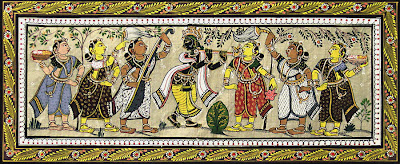Piriti and Chandidas's humanism
I had a break yesterday and plunged back into Chandidas. I was reading Biman Bihari Majumdar's edition, which has much to say for it, as he has gone deeply into the Chandidas mystery, sorting out which Chandidas is which. There are so many Chandidasas -- minimum four, probably five or more. Majumdar divides his book into four sections: definitely Chandidas, not so sure, definitely Baru Chandidas and Dina Chandidas, and ones that though ascribed or attributed are definitely not the original Chandidas. Many of the latter are signed Dvija Chandidas, who is definitely post-Chaitanya, though he shows no direct knowledge of or devotion to Chaitanya. The rāgātmikā-padas of the Sahajiya Chandidas are left out entirely, since everyone seems to agree that they are post-Chaitanya. Majumdar also thinks Baru Chandidas is at least contemporary with Chaitanya, which I don't agree with. Basically all the students of early Bengali literature pick over each pada and choose which au
